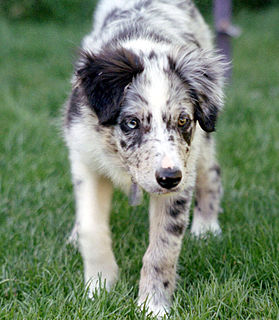
The German Shepherd is a breed of medium to large-sized working dog that originated in Germany. In the English language, the breed's officially recognized name is German Shepherd Dog. The breed was officially known as the Alsatian in Britain until 1977 when its name was changed back to German Shepherd. Despite its primitive, wolf-like appearance the German Shepherd is a relatively new breed of dog, with their origin dating to 1899. As part of the Herding Group, German Shepherds are working dogs developed originally for herding sheep. Since that time however, because of their strength, intelligence, trainability, and obedience, German Shepherds around the world are often the preferred breed for many types of work, including disability assistance, search-and-rescue, police and military roles, and acting. The German Shepherd is the second-most registered breed by the American Kennel Club and seventh-most registered breed by The Kennel Club in the United Kingdom.

The Border Collie is a working and herding dog breed developed in the Scottish borders for herding livestock, especially sheep. It was specifically bred for intelligence and obedience.
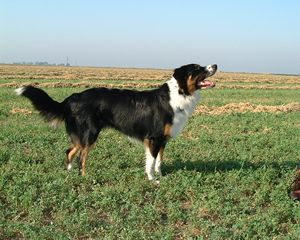
The English Shepherd is an extremely versatile breed of working dog of the collie lineage, developed in the United States from farm dogs brought by English and Scottish settlers in the 17th through 19th centuries before pedigrees became fashionable around the end of the 19th century. Subsistence farmers appreciated the breed for their versatility and not for their flash or strict conformation to a standard of appearance.

Collies form a distinctive type of herding dogs, including many related landraces and standardised breeds. The type originated in Scotland and Northern England. Collies are medium-sized, fairly lightly built dogs, with pointed snouts. Many types have a distinctive white color over the shoulders. Collies are very active and agile, and most types of collies have a very strong herding instinct. Collie breeds have spread through many parts of the world, and have diversified into many varieties, sometimes mixed with other dog types. Some collie breeds have remained as working dogs for herding cattle, sheep, and other livestock, while others are kept as pets, show dogs or for dog sports, in which they display great agility, stamina and trainability. While the American Kennel Club has a breed they call "collie", in fact collie dogs are a distinctive type of herding dog inclusive of many related landraces and formal breeds. There are usually major distinctions between show dogs and those bred for herding trials or dog sports, the latter typically display great agility, stamina and trainability, and, more importantly, sagacity.
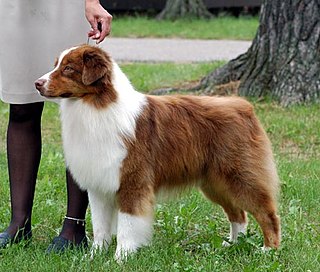
The Australian Shepherd, often known simply as the "Aussie", is a medium-sized breed of dog that was, despite its name, developed on ranches in the Western United States during the 19th century. There is disagreement regarding the exact history of the breed prior to its arrival in the United States, and thus no official consensus on the origin of its name or association with Australia.
A guard dog or watch dog is a dog used to guard against, and watch for unwanted or unexpected people or animals. The dog is discriminating so that it does not annoy or even attack familiar people.

The McNab Dog - commonly called McNab Shepherd or McNab Collie - is a herding dog that originated in the Mendocino region of Northern California. The McNab was bred to withstand the tough conditions found in California such as heat, burrs, foxtails, and rugged terrain. Until recently, the McNab was little known outside California, but the last three decades have seen a gain in popularity and geographic dispersal of the breed.
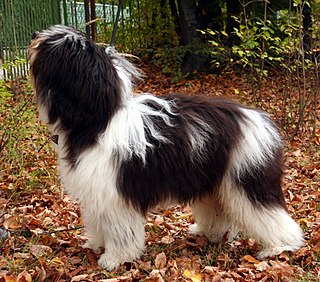
The Polish Lowland Sheepdog, is a medium-sized, shaggy-coated, sheep dog breed native to Poland.

The Welsh Sheepdog is a landrace of herding dog from Wales. Some people incorrectly call a Welsh Sheepdog a Welsh Collie - usually 'Welsh Collie' is used for a cross between a Welsh Sheepdog and a Border Collie, who is often a milder dog and easier to manage than the pure breed.
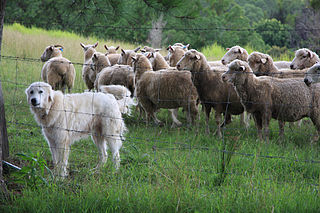
A livestock guardian dog (LGD) is a type of pastoral dog bred for the purpose of protecting livestock from predators.
The Cumberland sheepdog is an extinct dog breed related to the border collie and other old working collie types. It is claimed to be one of the ancestors of the Australian shepherd and in the early part of the 20th century some Cumberland sheepdogs were being referred to as border collies and may have been absorbed into the latter breed.

A shepherd or sheepherder is a person who tends, herds, feeds, or guards herds of sheep. Shepherd derives from Old English sceaphierde.
The Chiribaya Dog or Peruvian shepherd dog was a pre-Columbian breed of dog from the southwest of Peru, identified by the 42 mummies discovered by anthropologist Sonia Guillén Oneglio in the Ilo District, Moquegua Region, on the south coast of Peru. It has been established that it was a llama herding dog. The dogs were not only an important part of the social structure of the ancient Peruvians, but they received special treatment after death as well. The dog variety has been referred to in various Spanish-language documentaries under different terms, such as el perro pastor Chribaya and pastor Peruano, though the ancient Peruvians did not keep sheep. Its original name is unknown.

The Old Time Farm Shepherd is a rare breed of working dog known for its versatility and intelligence. Old Time Farm Shepherds are the descendants of the old working Scotch Collies that were common on farms in America in the early twentieth century; as a recognized breed, they were started by J. Richard McDuffie in 1994.

Mountain dogs are a generic form of dog, a group of similar or related dog breeds or landraces typically from the mountain environs of central Eurasia.

The New Zealand Heading Dog is a working and herding dog that uses its visual prowess and quick movement to control sheep. Bred from Border Collies, Heading Dogs are a sturdy, long-legged and even-haired breed. They are generally black and white in color, but may also be tan.
The Welsh Grey or Old Welsh Grey was a breed of sheepdog native to Wales. It is probably now extinct, although it may have contributed to the makeup of the Welsh Sheepdog.
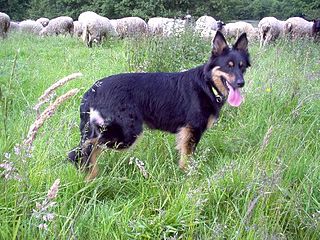
The old German herding dogs, including old German sheep-dogs or old German shepherd dogs are a group of traditional types of working, herding dogs from Germany. They are landraces consisting of working strains of dog, and some of them are the types from which the modern German Shepherd Dog was developed as a standardised breed. The landraces are not recognised by the Fédération Cynologique Internationale, but some have their own standards which are for working ability, not appearance traits.



